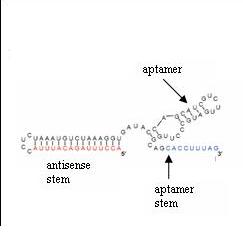Difference between revisions of "Antiswitches"
(→Design) |
(→Design) |
||
| Line 3: | Line 3: | ||
==Design== | ==Design== | ||
| − | Antiswitches are made of an aptamer and two stems: the aptamer stem and the antisense stem. | + | Antiswitches are made of an aptamer and two stems: the aptamer stem and the antisense stem. |
| + | |||
| + | [[Image:Switch.JPG]] | ||
| + | |||
The aptamer is the sequence that binds the ligand and causes a conformational (shape) change of the antiswitch molecule. Aptamers can be highly specific for their particular molecules. The theophylline aptamer used by Smolke and Bayer can distinguish between caffeine and theophylline, which differ by a single methyl. | The aptamer is the sequence that binds the ligand and causes a conformational (shape) change of the antiswitch molecule. Aptamers can be highly specific for their particular molecules. The theophylline aptamer used by Smolke and Bayer can distinguish between caffeine and theophylline, which differ by a single methyl. | ||
Revision as of 03:19, 13 November 2007
Antiswitches, trans-RNA molecules that regulate translation of mRNA based on ligands, were first developed by Smolke and Bayer (2005) in Saccharomyces cerevisiae. Two types of antiswitches were engineered: on-switches and off-switches. On-switches turn on gene expression in the presence of the ligand while off-switches turn off gene expression in the presence of ligand.
Design
Antiswitches are made of an aptamer and two stems: the aptamer stem and the antisense stem.
The aptamer is the sequence that binds the ligand and causes a conformational (shape) change of the antiswitch molecule. Aptamers can be highly specific for their particular molecules. The theophylline aptamer used by Smolke and Bayer can distinguish between caffeine and theophylline, which differ by a single methyl.
While Smolke and Bayer mainly used the aptamer for the ligand theophylline, aptamers for many other molecules are now being generated using rational design. The large number of possible aptamers provides versatility in what will control gene expression.
The antisense stem contains a sequence that complements a targeted RNA transcript and a second sequence that sequesters this complementary sequence to keep it from binding the transcript. When the antisense stem is not duplexed with itself, it prevents translation by binding to the complementary mRNA.
The aptamer stem is a short sequence that complements a portion of the sequestering sequence of the antisense stem. In an off-switch, the aptamer stem swings towards the antisense stem and displaces the portion that complements the targeted transcript when the liand binds to the aptamer. In an on-switch, the aptamer swings away from the antisense stem when the ligand bids to the aptamer; thus, the antisense stem can duplex and is no longer free to bind to the transcript.


